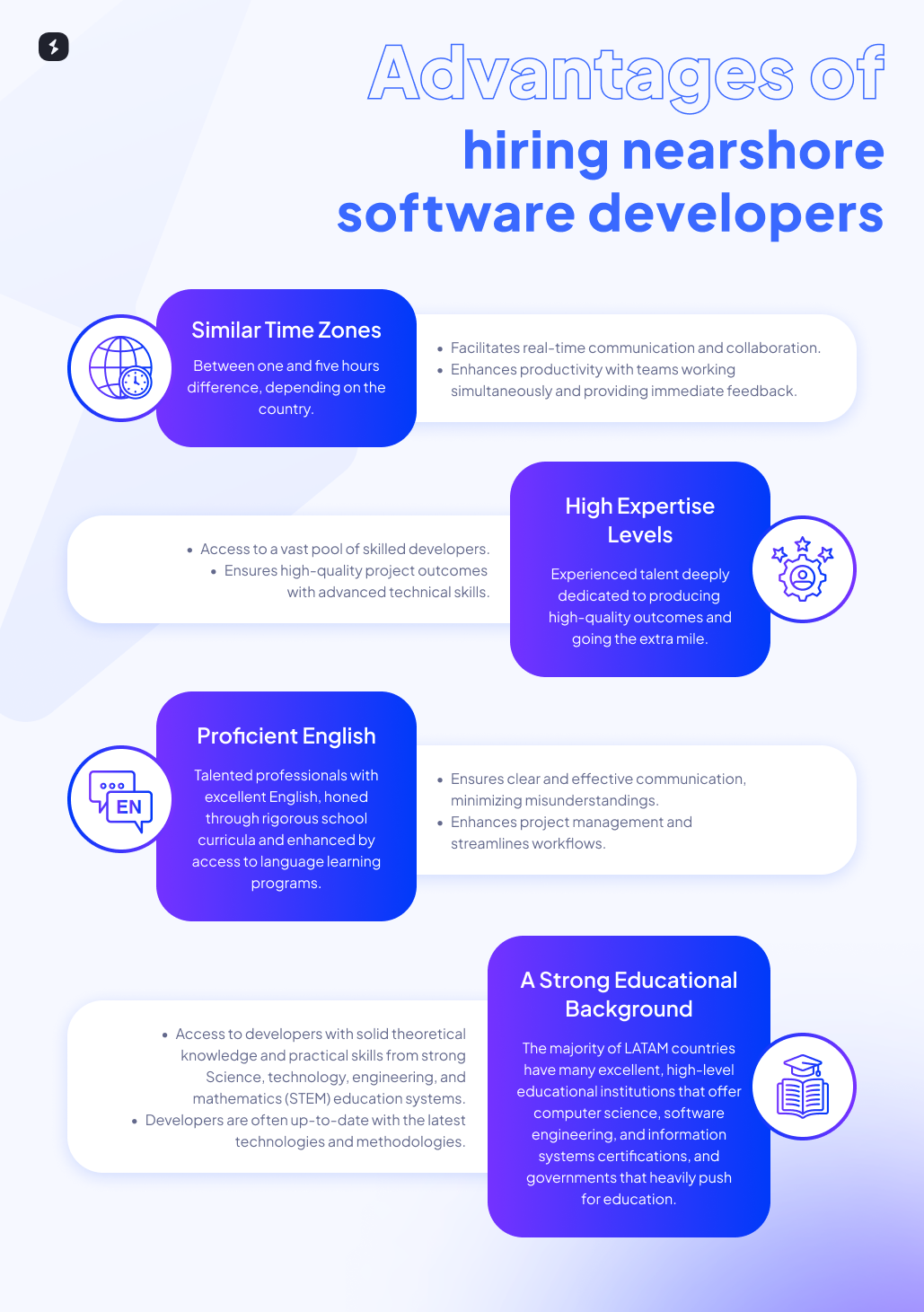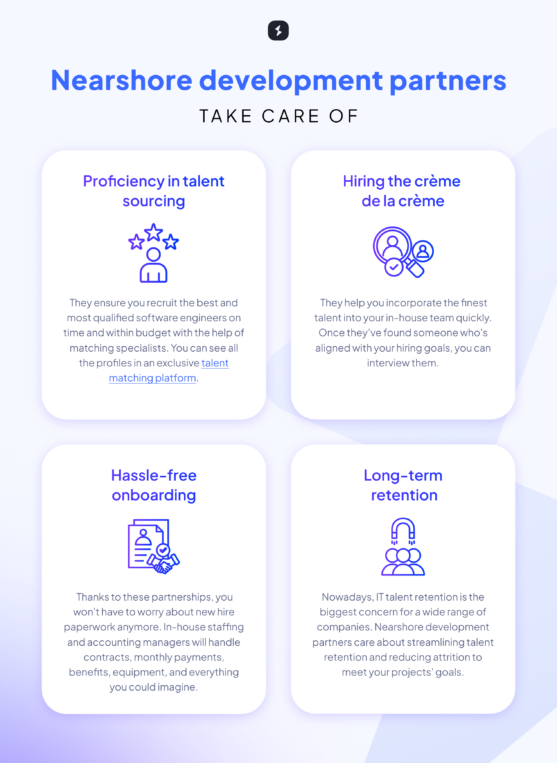
Nearshore Software Development Rates: The Complete Guide for Midsize Companies
As the tech industry evolves, finding and engaging experienced and cost-effective software developers remains one of the biggest challenges for companies.
According to the U.S. Bureau of Labor Statistics, software developer demand is projected to grow by 22% by 2029 — much faster than most other professions. This means that recruiting top talent is becoming increasingly competitive, which calls for nearshore software development to gain traction.
Nearshore software development has emerged as the go-to approach for U.S. companies looking to expand their development teams. To begin with, it offers similar time zones and cultural compatibility.
But here’s where it gets better.
Nearshore software development also provides access to a large talent pool of outstanding software developers at a fraction of local hiring costs.
At this point, you’re probably wondering: What are the real annual rates of hiring nearshore software developers?
Whether you’re expanding into new markets or planning to expand your existing IT team with cost-effective and high-quality top performers, this article is for you.
In this post, you’ll discover:
- Key factors influencing nearshore development rates;
- Insights into nearshore software developers’ average annual rates in 2024.
Let’s dive in.
What Are Key Factors Influencing Nearshore Software Development Rates?
Before delving into nearshore development rates, it’s crucial to understand that setting them isn’t a walk in the park. There are various factors that influence these rates, including:
- Technical expertise and experience levels
- Skill sets that are currently in high demand
- Scope of the project
- Geographic location
Technical Expertise and Experience Levels
The cost of hiring a nearshore software developer depends on their experience level—whether junior, semi-senior, or senior.
Developers with extensive experience in some technologies demand more competitive salaries and additional benefits. These include more effective talent management, work-life balance, and the flexibility to work from anywhere.
The standout advantage? Experienced developers require less structured training than beginners. They seamlessly integrate into your projects, contributing value from the very first day.

Skill Sets that are Currently in High Demand
Similar to the previous section, the most sought-after tech skills command premium salaries. It’s a simple case of supply and demand. However, these aren’t just trendy skills. They represent areas of technology that require deep, comprehensive training and a significant investment of time to master.
As these technical talents become scarcer, the power shifts towards employees, allowing them to negotiate for higher salaries that reflect their valuable knowledge.
To give you an idea, these are the top-paying skills in the U.S. for 2024:
- Business Analyst
- Data Scientist
- DevOps Engineer
- Applications Engineer
- Full-stack developer
- Front-end developer

Overall, as companies seek to hire professionals with expertise in popular frameworks and languages, the competition for skilled developers drives up prices.
Scope of the Project
Typically, the larger a project’s scope, the more complex it becomes. Why? These projects often require additional human resources and cutting-edge technologies.
Consider, for example, the development of a SaaS platform. This type of project calls for a diverse team made up of software engineers, product designers, and user experience (UX) designers, among others. Depending on the platform’s purpose, it may also require advanced technologies like cloud computing, artificial intelligence, and robust security protocols (e.g., incorporating HIPAA compliance regulations) to ensure system integrity.
Moreover, projects with larger scopes involve extensive feedback sessions and thorough testing phases to identify and fix any issues before launch. These lengthy processes can lead to developers spending more time on the project, thereby increasing costs.
Geographic Location
The cost of living in the country where software developers reside can influence their salary expectations. In European countries, such as Germany and France, the cost of living—and consequently, salaries—tend to be higher. This situation can stretch the budget of a company looking to scale.
Conversely, countries with more affordable talent like India or Ukraine can present significant time zone differences, cultural distinctions, and language barriers with U.S.-based companies.
These factors can lead to inconsistencies, misunderstandings, and other communication issues that may extend project deadlines, resulting in higher costs.
Fortunately, if your company is based in the United States, there’s no need to worry. The cost of living in Latin America is considerably lower, allowing software developers earning between 5k to 8k USD per month to enjoy a comfortable lifestyle.
It’s important to note that living costs can vary significantly across Latin American countries. For example, Uruguay’s cost of living is 93.3% higher than Argentina’s, which leads to increased average rates. However, this isn’t a major concern. Despite these variations, the savings companies achieve by hiring Latin American developers instead of local talent are still substantial.
The best part? These professionals offer:
- Timezone aligned;
- High levels of expertise;
- Proficient English;
- And strong educational backgrounds.

No matter where the talent is from, whether it’s Brazil, Chile, Mexico, or anywhere else in the region, integrating a remote Latin American software developer team is an accessible and effective solution for meeting your project needs.
So, How Much Does it Cost to Hire a Nearshore Software Developer?
In this section, we’ll share the average nearshore development rates with a focus on Latin American talent. We’ll categorize these rates into three groups:
- The cost of hiring developers through a nearshore development partner;
- The cost of hiring nearshore software developers in Latin America;
- The cost of hiring nearshore software developers based on roles.
Disclaimer: Our average rates are for senior software engineers from Latin America, assuming you’re an executive at a U.S. company looking for professionals with extensive experience.
Let’s dive in.
Cost of Hiring Developers by Country Through a Nearshore Development Partner
If you’re looking for software developers who match local skill levels, but lack the human resources to handle a successful and budget-friendly hiring process, nearshore software development partners (also known as IT staffing companies) can be your allies. Unlike platforms like Upwork, which focus on hiring all kinds of freelance talent, these nearshore partners specialize in software developers from Latin America. They offer a combination of:
- Brand awareness
- In-depth tech industry knowledge
- A team of experienced recruiters
This enables them to conduct hundreds of interviews with top-tier developers yearly.

The average salary of software developers with a nearshore development partner varies between US $62,400 and $127,200. However, the final cost can vary based on seniority and technology.
Would you like to compare the costs of hiring Latin American developers by technology through a nearshore development partner? Check out our cost calculator for detailed insights.
The Cost of Hiring Developers by Country Through a Nearshore Development Partner
| Countries | Annual rates in USD |
| Argentina | Between US $103,200 and $121,200 |
| Brazil | Between US $104,400 and $127,200 |
| Costa Rica | Between US $94,800 and $115,200 |
| Colombia | Between US $79,200 and $110,400 |
| Chile | Between US $84,000 and US $115,200 |
| Perú | Between US $75,600 and US $104,400 |
| México | Between US $84,000 and $115,200 |
| Uruguay | Between US $84,000 and $111,600 |
| Honduras | Between US $62,400 and $86,400 |
| Ecuador | Between US $75,600 and $104,400 |
| Paraguay | Between US $75,600 and $104,400 |
| Dominican Republic | Between US $84,000 and $111,600 |
| Panama | Between US $70,800 and $98,400 |
| El Salvador | Between US $67,200 and $92,400 |
*Salary, benefits, taxes, and fees (BEON.tech fee included) / Source: BEON.tech data
The Cost of Hiring Nearshore Software Developers in Latin America
Now you have a clear picture of the cost of hiring software developers by country through a reputable IT staffing agency.
If you already have a solid HR team, you might be interested in knowing the cost of hiring a software developer outside of an agency. Keep in mind that these costs don’t include extra expenses, such as onboarding costs, equipment stipends, additional benefits and perks, payroll, and talent management.
The average senior software developer salary in Latin America ranges from USD 64,000 to USD 104,700 per year, depending on the country.
For instance, Argentinian senior software developers earn between USD 90,000 and USD 102,000 per year, and Brazilian software developers earn between USD 80,000 and USD 102,000 per year.
The average salary of Latin American software developers by country
| Countries | Annual rates in USD |
| Argentina | Between US $90,000 and $102,000 |
| Brazil | Between US $80,000 and $102,000 |
| Costa Rica | Between US $72,000 and $126,000 |
| Colombia | Between US $67,000 and $95,000 |
| Chile | Between US $65,000 and US $90,000 |
| Perú | Between US $64,000 and US $90,000 |
| México | Between US $79,000 and $113,000 |
| Uruguay | Between US $78,000 and $117,000 |
| Honduras | Between US $69,912 and $104,700 |
*Salary ranges include payroll benefits and only consider professionals who are proficient in English.
Source: Levels.fyi
The Cost of Hiring Nearshore Software Developers Based on Role
Whether you choose to hire through a nearshore agency or use an in-house HR and talent management team, you already know how cost-effective hiring senior developers from Latin America can be. But if you go with the latter, what are the costs based on different roles?
Here’s a quick overview of the average cost to hire a developer from LATAM based on roles:
| Role | Annual Latin American rates in USD | Annual rates in United States |
| Frontend developers | Between US $64,000 and $108,000 | Between US $132,000 and $300,000 |
| Backend developers | Between US $64,000 and $114,000 | Between US $130,000 and $270,000 |
| Full stack developers | Between US $66,000 and $130,000 | Between US $113,000 and $280,000 |
Source: Glassdoor, Indeed, Levels.fyi
Are you considering hiring freelance software developers instead? Read this post to learn more about their costs and salary comparisons with full-time software developers.
Let’s Power-Up Your Tech Team With Top-Tier Nearshore Software Developers
In this post, we covered the annual software development rates associated with hiring a highly experienced nearshore software developer.
As you can see, hiring top-tier developers from Latin America could be significantly more affordable compared to the cost to hire a software developer in the U.S. This solution allows you to secure top performers without incurring the high costs associated with U.S.-based professionals, where the senior software developer salary can be quite substantial.
If you’re looking for the right IT staffing partner to expand your IT team, we can lend a hand. At BEON.tech, we pride ourselves on being a process-conscious, expertise-driven IT staffing company chosen by midsize and large U.S. companies to augment their teams with outstanding LATAM software developers.
We help our clients in:
- Finding pre-vetted candidates within the top 3% of software developers from Latin America;
- Conducting interviews tailored to their hiring process and technical requirements;
- Avoiding the hassle of handling contract management, compliance, and all hiring operations, including payment;
- Building a robust framework for guaranteed retention.
Interested in learning more? Schedule a call with one of our representatives to discover how BEON.tech is already assisting organizations like yours.
Explore our
These Are Our 4 Tools For Creating Prime Culture And Talent Engagement
What’s Organizational Culture? Is it the mission and values of a company? Its benefits? We could say that all of this is part of and makes up the culture, but at BEON.tech, we believe that the most important thing is our people. Felipe Zacani, Node.js engineer from Brazil working with AutoFi, describes BEON’s culture as…
10 Tips To Land Remote Jobs as a Non-U.S. Remote Developer
Working remotely and exploring remote jobs for non-U.S. residents as a developer in Latin America can be exciting and challenging at the same time. To ensure a successful collaboration, it’s essential to establish a good impression from the beginning and adopt effective work practices. We know that it’s a big leap for your professional careers…
How to Hire Remote Software Developers in Healthcare: What Executives Need to Know
Remote work in healthcare has become the norm, ranking fifth among industries with growing remote workers. And this is especially true when it comes to software engineers in the healthcare industry. The reason is quite simple: the number of healthcare tech companies that develop medical software, applications, and data analytics is on the rise, and…






